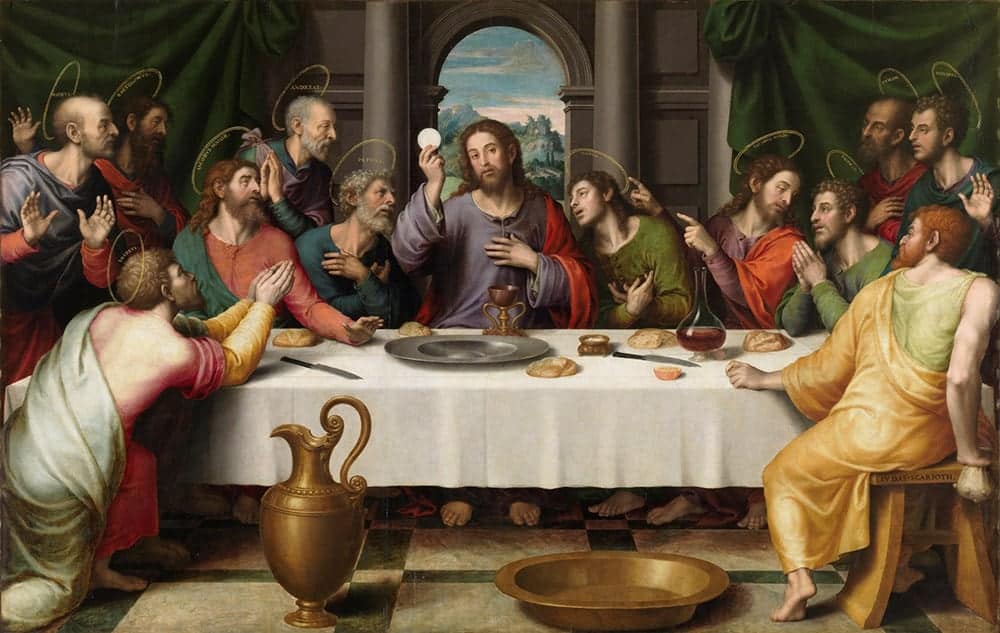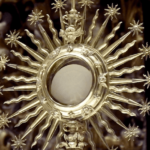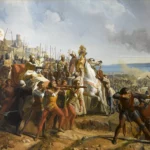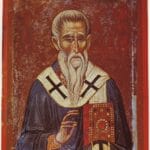Get ready to embark on a captivating journey through time as we delve into the rich history of the Eucharist, a sacrament at the very heart of Christian practice. From its ancient roots to its modern significance, we’ll unravel the evolution of this sacred ritual and explore the profound meaning it holds for Christians worldwide. Join us as we uncover the historical milestones, theological debates, and enduring legacy of the Eucharist, a testament to the power of faith and tradition across the ages.
History of the Eucharist Timeline
The Eucharist, often referred to as Holy Communion or the Lord’s Supper, is a central act of Christian worship. But where did this tradition of bread and wine, believed to represent the body and blood of Jesus Christ, originate? Let’s trace the roots and evolution of this sacred ritual:
Hints of the Eucharist in Ancient Times:
- The Tree of Life: Even before the time of Jesus, ancient cultures utilized the image of a tree bearing life-giving fruit to symbolize spiritual nourishment, an idea that likely influenced how Christians later viewed the Eucharist.
- Exodus and Passover: The story of the Israelites’ exodus from Egypt and their annual Passover meal, with its symbolic foods and themes of liberation, provided a powerful backdrop for understanding the Eucharist. Just as the Passover lamb symbolized freedom, the Eucharist, too, would come to represent Jesus as the ultimate sacrifice that frees humanity from sin.
Jesus Starts a New Tradition:
- The Last Supper: At the heart of Christian faith lies the story of Jesus sharing a final meal with his disciples. During this gathering, the Last Supper, Jesus broke bread and shared wine, instructing his followers to “do this in remembrance of me.” This act initiated the Eucharist.
- Powerful Metaphors: Jesus’ offering went beyond simple food; he used profound language to explain the deeper meaning of the bread and wine. Calling himself “The Bread of Life,” he suggested he offers spiritual sustenance, and referring to himself as “The Lamb of God,” he alluded to the sacrificial nature of his death.
The Early Church Keeps the Memory Alive:
- Writings from the First Christians: We can glean insights into how early Christians understood and practiced the Eucharist through letters, gospels, and other texts written in the years after Jesus’ death. These writings offer glimpses into the rituals and beliefs surrounding this sacred meal.
- The Didache: One early Christian document, known as the Didache (meaning “teaching”), provides valuable instructions on how the Eucharist should be celebrated, offering a window into how this ritual took shape within the first Christian communities.
Centuries of Thought and Debate:
- Shaping Theology: Over the centuries, the meaning and significance of the Eucharist were intensely debated by theologians and church leaders. Great councils were convened, and different branches of Christianity developed their own interpretations, leading to a diverse tapestry of beliefs about the Eucharist’s true nature.
- Rituals and Practices: Just as beliefs about the Eucharist evolved, so too did the rituals surrounding it. What began as a simple meal shared by Jesus and his disciples gradually transformed into more formalized liturgical practices. These practices vary across different Christian denominations today.
The Eucharist Today: A Living Tradition:
- The Heart of Community: For many Christians around the world, the Eucharist remains a source of profound spiritual connection. It’s a time to gather as a community, to remember Jesus’ sacrifice, and to be nourished in faith.
- A Legacy that Endures: The story of the Eucharist is a testament to the enduring power of faith and tradition. It’s a story that began with a humble meal and continues to unfold as each generation encounters the mystery and meaning of this sacred ritual.
When did the Eucharist originate?
The Eucharist holds immense importance for Christians, but when and where did this tradition begin? It wasn’t a spontaneous creation; its roots run deep into history, even predating Christianity itself.
Ancient Jewish traditions offer possible glimpses into the Eucharist’s origins. The Todah, a sacrifice of thanksgiving, and Passover, a commemoration of liberation, share elements that suggest the Eucharist may have evolved from existing customs.
The pivotal moment, however, is Jesus’ Last Supper with his disciples. On the eve of his crucifixion, Jesus shared bread and wine, instructing them to “do this in remembrance of me.” This act, recounted by the apostle Paul in Corinthians (circa 55 AD), is considered the institution of the Eucharist.
Imagine this scene replicated over time, first by the disciples, then their followers, and so on. The ritual evolved; initially a weekly observance, it became a daily practice for some. The prayers, readings, and even the precise practices surrounding the Eucharist developed over time, leading to variations among different groups.
Eventually, the Roman rite, the way the Catholic Church celebrates the Eucharist, became the most widespread form. While variations still exist, it remains the most common practice.
While we can trace the Eucharist back to Jesus’ Last Supper, its history is complex. Researchers continue to explore the connections between the Eucharist and older Jewish customs, seeking to understand their influences. They also study early Christian writings, comparing accounts of the Last Supper to uncover how the understanding of the Eucharist may have shifted in the years following Jesus’ death.
The Eucharist’s journey from a single meal to the diverse practices we see today is a story still being pieced together.
Is the Eucharist Pagan?
The Eucharist, the bread-and-wine ritual central to Christian practice, commemorates Jesus’ sacrifice and fosters a sense of connection with him and fellow believers. Its history is multi-layered, with influences from various times and places. Given Christianity’s roots in Judaism, it’s natural to wonder about connections between the Eucharist and pre-Christian practices.
Consider the Jewish Passover Seder, a gathering with symbolic foods narrating the story of their freedom. The shared cup of blessing in this tradition bears resemblance to the Eucharist, suggesting a possible foundation. While unique to Christianity, the Eucharist may be rooted in earlier traditions.
Some scholars have noted similarities between the Eucharist and practices of ancient mystery religions, groups with beliefs distinct from Judaism or early Christianity. These parallels raise questions about potential influence on early Christians.
Think of it this way:
- The Passover Seder: Like a grandparent, passing down traditions that shaped the Eucharist.
- Similarities to mystery religions: Distant cousins – a family resemblance exists, but the extent of their connection is debated.
Research is ongoing, and new discoveries could shift our understanding. It’s an intriguing exploration of how beliefs intersect and influence one another.
What is the difference between the Eucharist and Communion?
The terms “Eucharist” and “Communion” often describe the Christian ritual of sharing bread and wine as symbols of Jesus. For many, they are interchangeable, both emphasizing the remembrance of Jesus’ sacrifice and fostering connection.
The nuance lies in differing views within Christianity regarding the nature of the bread and wine.
Catholics believe in “transubstantiation,” a concept signifying that the bread and wine are transformed into the actual body and blood of Christ. It’s not merely symbolic; it’s a profound, sacred experience of Jesus’ true presence.
Protestants, while finding deep meaning in the ritual, tend to view it differently. They might say the bread and wine represent Jesus’ body and blood, aiding in remembering his sacrifice and fostering a spiritual connection. They don’t necessarily subscribe to the belief in physical transformation.
It’s akin to viewing the same painting – interpretations differ, but the artwork holds significance for all.
Research into these beliefs and their historical development continues, enriching our understanding of early Christians’ perception of the Eucharist.
Ultimately, despite varied interpretations, both Catholics and Protestants find profound meaning and connection through this act of remembrance, demonstrating the enduring power of faith and tradition.
When did transubstantiation begin?
Transubstantiation, the Catholic belief that the bread and wine used in Communion transform into the body and blood of Christ, is a complex concept. Understanding its emergence requires a journey through centuries of theological discussions.
While the Catholic Church has always maintained that the Eucharist is more than symbolic, the concept of transubstantiation as we understand it today didn’t appear overnight.
Early Church writings, such as those of Justin Martyr and Irenaeus, described the Eucharist as a sacrifice, a way to remember and participate in Christ’s sacrifice. By the 4th century, the Church was delving deeper. The Council of Nicaea in 325 AD affirmed that the bread and wine were “the body and blood of Christ,” but the mechanics remained unexplained.
The 12th century marked a turning point. The Fourth Lateran Council in 1215 employed the term “transubstantiation” and offered a more detailed explanation. They emphasized that the bread and wine, while maintaining their appearance and taste, actually become the body and blood of Christ.
This concept has been met with debate. Some theologians argue that the bread and wine remain symbolic. However, the Catholic Church grounds its belief in Jesus’ words at the Last Supper: “This is my body” and “This is my blood.”
Theological exploration of transubstantiation continues. It’s a concept that has developed over time, and our understanding of it may continue to evolve. Grasping its complexities requires delving into the theological discussions and historical context surrounding this central belief.
Did the first Christians believe in the Eucharist?
The question of whether the very first Christians believed in the Eucharist is a compelling one. Evidence suggests that it held a significant place in their faith.
One of the earliest Christian documents, the Didache, written between 60-100 AD, provides instructions for early Christians, including specific mentions of the Eucharist. The Didache even emphasizes the importance of confession and spiritual preparation before partaking, suggesting the seriousness with which they regarded the ritual.
The Eucharist wasn’t merely a ritual for early Christians; it was deeply symbolic, representing the body and blood of Jesus. They took Jesus’ words at the Last Supper to heart, viewing the bread and wine as a physical manifestation of his sacrifice.
However, history is ever-evolving. As Christianity spread, so did the Eucharist, and interpretations varied among different cultures and theological schools. The core idea endured, but rituals, specific beliefs, and the perceived importance of the Eucharist shifted over time and within different branches of Christianity.
While we can’t directly ask those early Christians about their beliefs, the evidence points to the Eucharist’s central role in their faith from the outset. It’s captivating to trace its evolution over time, showcasing its enduring importance.
Does the Eucharist Appear in the Bible?
While the word “Eucharist” might not appear verbatim in the Bible, the concept behind it – the sharing of a sacramental meal – is present in the Gospels and other New Testament writings.
The Gospel accounts of the Last Supper, particularly in Matthew, Mark, and Luke, depict Jesus blessing, breaking, and sharing bread and wine with his disciples. This act, imbued with profound meaning, marked a departure from a typical meal. Jesus declared that the bread represented his body and the wine his blood, signifying his sacrifice.
The Apostle Paul, in his letter to the Corinthians, reinforces this idea. He stresses the significance of Christians continuing to share bread and wine in memory of Jesus, describing it as a “proclamation of the Lord’s death.” This act affirmed their belief in his sacrifice and anticipated his return.
Therefore, even though the term “Eucharist” isn’t explicitly used in the Bible as we use it today, the essence of the ritual – sharing bread and wine in remembrance of Jesus’ sacrifice – is undeniably a foundational element of early Christianity. It’s a seed that sprouted and flourished, with different branches of Christianity incorporating their own interpretations and practices. The core, however, remains rooted in Jesus’ actions at that pivotal Last Supper.
How did Jesus start the Eucharist?
The Eucharist, a practice enabling Christians to connect deeply with Jesus and one another, originated with Jesus himself.
During his final meal with his disciples, the Last Supper (recounted in the Gospels), Jesus shared bread and wine. However, it wasn’t merely a matter of passing food; it was a moment imbued with profound symbolism. He declared that the bread symbolized his body and the wine his blood, offering himself to them in a manner transcending a simple meal.
Imagine the weight of that moment, the disciples witnessing this transformative act. From that point forward, Christians regarded bread and wine as sacred symbols of Jesus’ sacrifice, believing that partaking in this meal connected them to his life, death, and resurrection. It’s a spiritual link, a path to experiencing closeness with Jesus.
Over time, different Christian groups developed unique ways of celebrating the Eucharist, referring to it as Communion or the Lord’s Supper. Regardless of the name, the core remains: remembering Jesus and his sacrifice. It’s a tangible reminder of God’s love, keeping Jesus’ teachings alive.
For centuries, people have gathered to share this meal, experiencing that same connection to Jesus. The Eucharist is a powerful, enduring tradition that continues to unite and inspire hope.
Who performed the first Eucharist?
The first Eucharist can be traced back to Jesus himself during the Last Supper. Imagine the scene: Jesus breaking bread, sharing wine, and uttering the words, “This is my body… this is my blood… do this in remembrance of me.” It was a moment of profound significance.
That act of sharing, that very first Eucharist, derives its name from the Greek word for “thanksgiving.” It’s a fitting title, as the Eucharist centers around remembering and expressing gratitude for Jesus’ sacrifice.
Over time, the Eucharist has evolved into a central practice for Christians. More than just a meal, it’s a sacred rite, a way to deepen the connection with Jesus and foster a sense of community with fellow believers. Many believe that Jesus is truly present in the bread and wine, adding a layer of profound meaning.
For centuries, people have gathered to break bread, share wine, and remember Jesus, just as he instructed. This enduring tradition continues to connect people across time and cultures, symbolizing his love and sacrifice.
What event in the Old Testament foreshadows the institution of the Eucharist?
The Old Testament often offers glimpses into future events, foreshadowing Jesus’ life and the sacraments. One such event, the Passover, stands out as a powerful prefigurement of the Eucharist.
Imagine the Israelites enslaved in Egypt, on the verge of God’s deliverance. However, danger lurks: the Angel of Death threatens their firstborn sons. God’s mercy provides a way out – each family must sacrifice a lamb and mark their doorposts with its blood, a shield against the devastating plague. The lamb’s sacrifice becomes a substitution, its life given to spare the Israelites.
This event transcends physical salvation; it speaks to a deeper spiritual reality.
Centuries later, this foreshadowing finds fulfillment in Jesus, the Lamb of God, who willingly sacrifices himself on the cross, his blood shed for the forgiveness of sins. The Passover lamb, once a symbol of deliverance from earthly bondage, points towards Jesus, who liberates us from sin and death.
Even the elements of the Passover meal hint at the Eucharist. The unleavened bread, symbolizing purity and haste, prefigures the Eucharistic bread, the body of Christ broken for us. The wine, a sign of joy and celebration, foreshadows Christ’s blood, poured out for the forgiveness of sins.
Rich in symbolism, the Passover doesn’t just foreshadow the Eucharist; it lays the foundation for understanding its depth. It reminds us that God’s plan of salvation unfolds over time, revealing his love and mercy gradually. The Eucharist becomes a participation in the ongoing story of redemption, a tangible reminder of God’s love made present in our lives.
Who started communion in the church?
The origins of Communion, this essential Christian practice, can be traced back to Jesus himself. During his last meal with his disciples, the Last Supper, he shared bread and wine. He imbued this act with profound significance, instructing them, “Do this in remembrance of me.” This marked the beginning of what would become a cornerstone of Christian worship.
As the early Christian community expanded, the Eucharist (as it’s also known) became a unifying ritual, connecting them to their faith and each other. They gathered on Sundays to share bread and wine, commemorating Jesus’ sacrifice and strengthening their community.
Early Church figures like Ignatius of Antioch, a disciple of the Apostles, wrote about the Eucharist’s power to unify. He declared, “Where the bishop is, there let the people be; and where Jesus Christ is, there is the Catholic Church.” This statement highlights the Eucharist’s central place in their understanding of the Church.
It’s crucial to acknowledge that over time, different branches of Christianity developed their own interpretations and practices surrounding Communion. The theology, the ceremonies – all shaped by the history and traditions of these groups. Yet, the core of Communion remains constant: it’s a sacred remembrance of Jesus’ sacrifice, a way to experience his presence, and a powerful symbol of love and unity binding Christians together.
This tradition, spanning centuries, connects believers across time and space, a testament to the enduring power of faith and community.
Key Points of the History of the Eucharist:
- Ancient Roots:
- Tree of Life: Symbol of spiritual nourishment
- Exodus and Passover: Prefigurement of the Eucharist’s liberating nature
- Jesus Establishes the Tradition:
- Last Supper: Institution of the Eucharist with bread and wine as remembrance
- Metaphors: “Bread of Life” and “Lamb of God,” highlighting Jesus’ sacrificial nature
- Early Christian Practice:
- Writings and Gospels: Offer insights into the beliefs and practices surrounding the Eucharist
- Didache: Provides instructions for celebrating the Eucharist
- Theological Debates and Liturgical Developments:
- Councils and Debates: Shaped the understanding and interpretation of the Eucharist
- Evolution of Rituals: From simple meals to formalized liturgical practices
- Modern Significance:
- Central Act of Worship: Unites Christians in remembrance and celebration
- Source of Spiritual Connection: Fosters a sense of closeness with Jesus and the community
- Enduring Legacy: Passed down through generations, continually unfolding in meaning
Do you want to know the turning points that shaped the beauty industry? Discover the riveting history of cosmetology timeline.
Immerse yourself in the fascinating history of papermaking timeline and witness how humans transformed everyday materials into a cornerstone of civilization.
Unravel the captivating history of revivals timeline and witness the remarkable resilience and adaptability of faith and spiritual expression through the ages.
- Senior at What Age: Benefits & Eligibility Guide - March 29, 2025
- Unlocking Senior Benefits: How Old is a Senior? Your Complete Guide - March 29, 2025
- Master Russian Politeness:A Guide to Saying Please - March 29, 2025
















